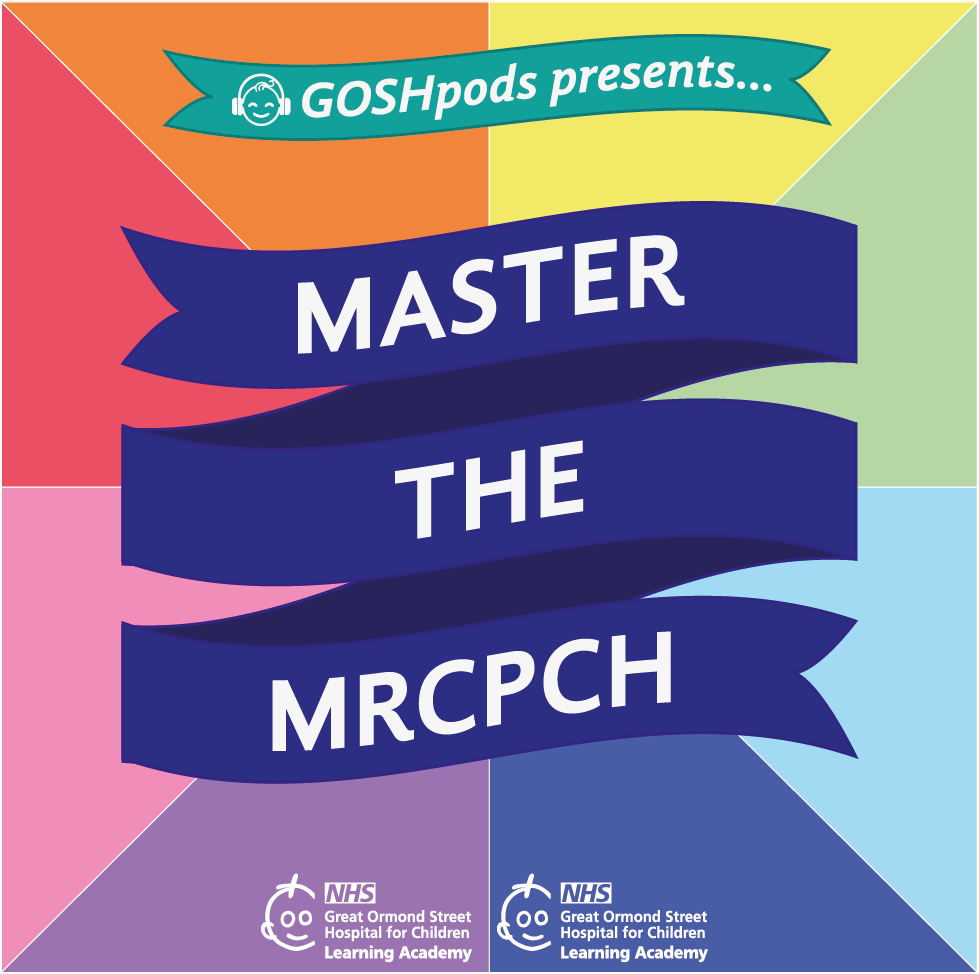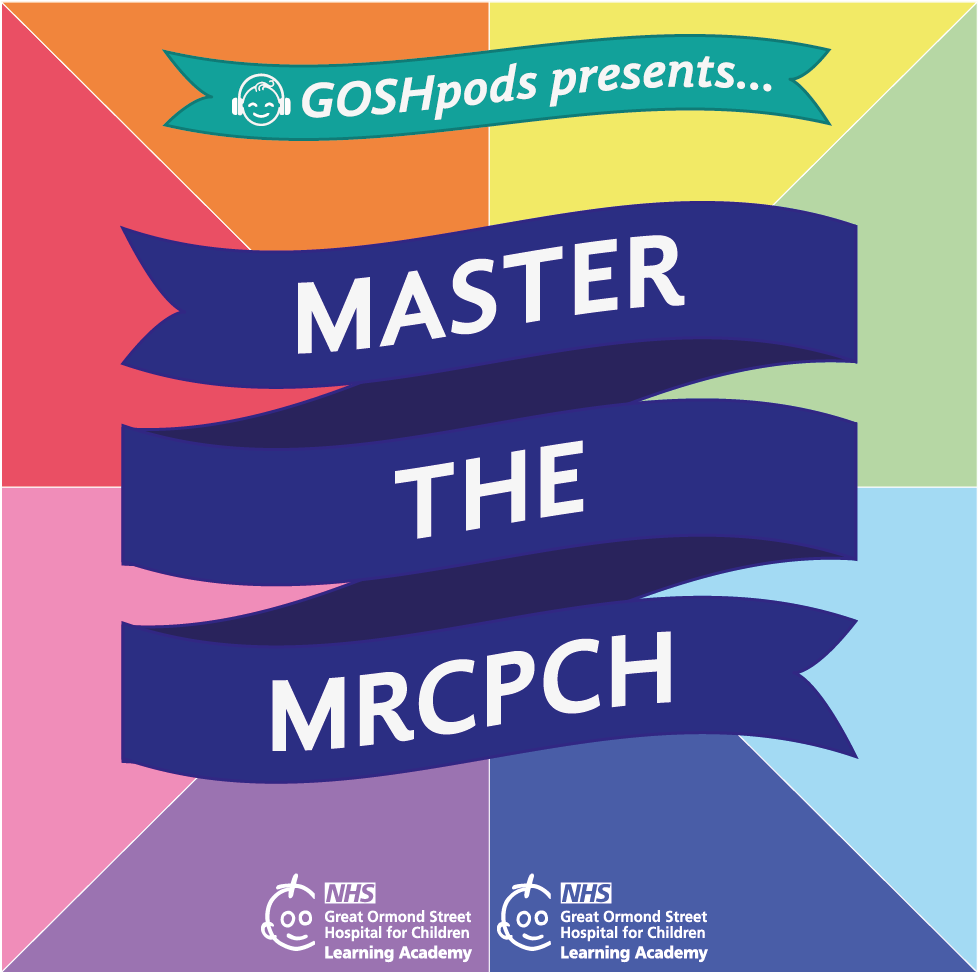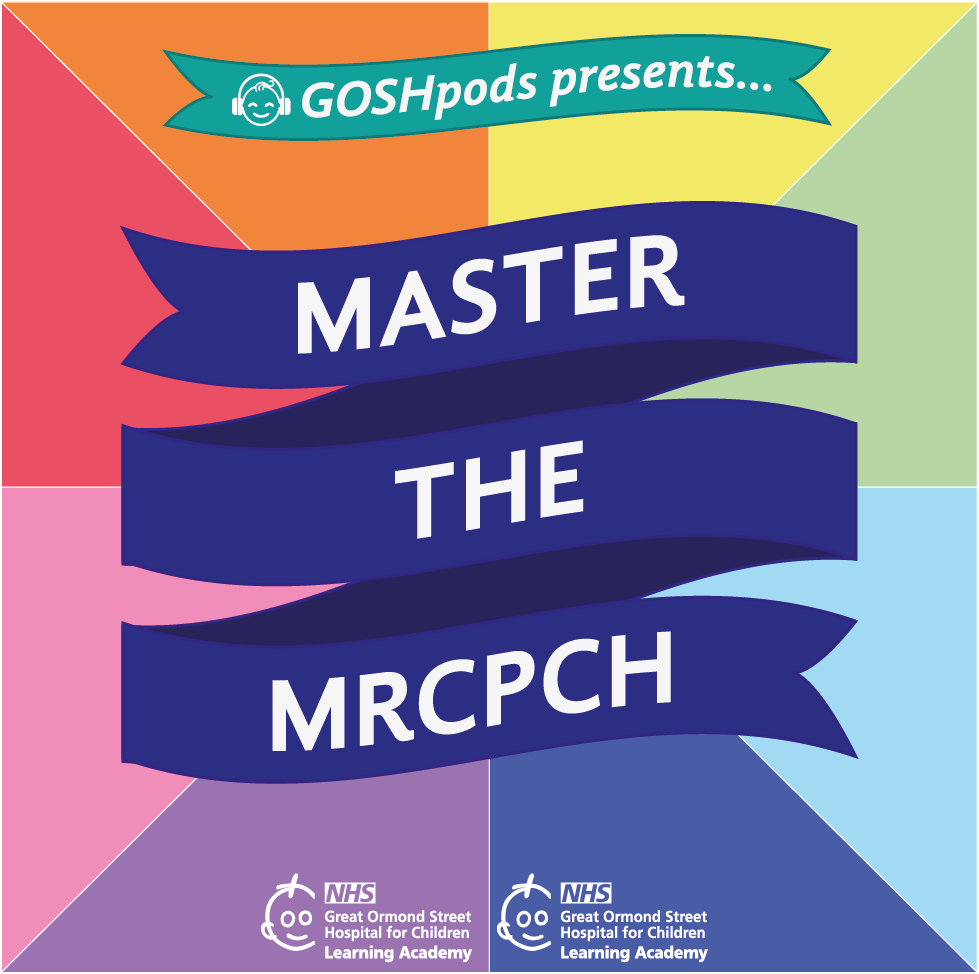This Podcast is brought to you by the GOSH Learning Academy.
SA: Hello, and welcome to Master the MRCPCH. In this series, we tap into the expertise here at Great Ormond Street Hospital to give you an overview of a topic on the RCPCH exam curriculum. So whether you're revising for an exam or just brushing up on a need to know topic. Hopefully this podcast can give you the information that you need.
I'm Dr. Sarah Ahmed, a paediatric registrar and the current digital learning education fellow here at GOSH.
In today's episode, we're going to be talking with Dr. Andrew Jones, a consultant in the CATS Retrieval Service and a PICU consultant at Great Ormond Street Hospital. This is the first of a two part episode on shock. Shock corresponds to the MRCPCH exam curriculum under the Emergency Medicine heading.
In this first episode, we're going to define what shock is and talk about haemorrhagic and hypovolemic shock. In the second episode, we're going to move on to talk about septic shock, neurogenic shock, and cardiogenic shock. I hope you join us for both.
Andrew, thank you so much for joining me today.
AJ: Thank you for having me.
SA: So before we delve into more detail, I wanted to start by asking, what would you like people to get out of listening to this podcast?
AJ: I would like them to understand what shock is, the different types of shock, how it's divided up clinically, and how to assess and treat children with different kinds of shock.
SA: I think that is a very good set of learning outcomes and hopefully we'll cover it all in the conversation today.
So let's start really basic, right at the very beginning. I think we talk a lot about shock in medicine, but I also think it's a term that gets bandied around a lot in layman's terms, so people say, “Oh, she's in shock.” From a medical point of view, what do we actually mean when we say someone has shock?
AJ: So there is actually another point of confusion as well, which I'll mention is that we use the term shock to describe a jolt of electricity to reset a heart arrhythmia. So I have been told, oh, there is a neonate with SVT who has been shocked. It's possible they have both physiological shock and have received electricity to sort out their heart rhythm.
SA: I hadn't thought of that, but yeah, no, you're absolutely right. Yeah, we do say that.
AJ: But the physiological definition, which you're, you're asking me for, it's actually surprisingly hard to neatly define and classify. But what I will offer you is that shock is defined as a state of cellular and tissue hypoxia, and that can be due to either reduced oxygen delivery, so heart failure, cardiogenic shock, increased oxygen consumption, something like malignant hyperthermia, or failure of oxygen utilization, something a bit niche like cyanide toxicity, or it could be a combination of those processes.
I think when we think about shock, physiological shock, what we're thinking about is circulatory failure. Mechanical failure of the circulation leading to poor oxygen delivery. And that is correct. And most shock will be that kind of shock, but there is this slightly small print, perhaps slightly geeky subtypes, which is mitochondrial failure. I mentioned that particularly because in paediatrics there are inborn errors of metabolism, which can affect mitochondrial function and cause energy failure. And we do see those patients and we certainly see them at GOSH, but for the most part, we're talking about reduced oxygen delivery due to mechanical failure of the circulation.
Now there is an equation. Very briefly, without scaring anybody off, there's an oxygen delivery equation, which is DO2, which is oxygen delivery, capital D, is cardiac output, CO, times arterial oxygen content, and that's CAO2. So oxygen delivery is cardiac output times arterial oxygen content.
Cardiac output, you'll be familiar with, stroke volume and heart rate. Arterial oxygen content takes into account the concentration of haemoglobin, the oxygen binding capacity of haemoglobin, the arterial oxygen saturation, and the partial pressure of oxygen. So most oxygen is bound to haemoglobin, there's a little bit that's dissolved into blood.
So any pathological process which affects any of those things that I mentioned will result in a state of shock, poor oxygen delivery. And that will lead to, as you can imagine, cellular hypoxia, cell membrane ion pump failure, intracellular oedema, dysregulation of intracellular pH, cell death, tissue death, organ death, and then the death of the patient if untreated.
SA: I didn't think we were going to jump into talking about equations, but I'm actually really glad that we did because I think actually, going back to basics is really helpful, especially with something like this. Do we as a medical profession have a way of classifying shock? I've heard previously people separate it into obstructive versus distributive. Is that still kind of a classification that is in use?
AJ: It certainly is. So a purely physiological classification focusing on mechanical circulatory shock would divide it up into cardiogenic, hypovolaemic, distributive and obstructive. That sort of four way classification is fairly traditional. I would, I would like to offer you a slightly more clinically orientated occasion if I may, where distributive shock is expanded into sort of three clinical sub definitions. And I have have an acronym, which is NACHOS PLUS. So N, yeah, I didn't invent it and I'll tell you actually later where I got it.
So N is neurogenic shock. So that's spinal cord or, brain injury, a lesion above T6 leading to a loss of sympathetic tone that results in bradycardia and decreased SVR, systemic vascular resistance, N
A anaphylactic, which you're probably mostly familiar with.
Cardiogenic, C, pump failure.
H is hypovolemic or hemorrhagic shock.
O, obstructive. So that can be an intra or extra cardiac obstruction. An extra cardiac obstruction to blood flow would be a tension pneumothorax, or an intracardiac obstruction would be tamponade –fluid in the pericardial space.
And then the S of NACHOS is septic. Septic shock is stagnation of blood flow owing to vasodilation.
And then the plus is everything else, the niche things, which are sort of a non mechanical failure of circulation in which I would include mitochondrial failure. So a failure to utilize the oxygen that's being delivered.
Within that classification, the distributive shock is neurogenic, anaphylactic, and septic. Does that make sense?
SA: It does. Yes, absolutely. I haven't heard that before. And I love it. It's great. Where, where did that come from?
AJ: There is a really fantastic website which I would thoroughly recommend called Deranged Physiology. If you Google it, it'll come up as the top hit. And it's kind of an ICU focused website by, I think, an intensivist in Australia, and it's brilliant. And he came up with the NACCHOs. I did actually add the plus.
SA: I will make sure that website is linked down below because it sounds great. So, given that we have the different types of shock I think it might be useful if we go through some of those in a little bit more detail. Should we start with haemorrhagic shock? Can you give us a definition of what that is?
AJ: So haemorrhagic shock is part of the hypovolemic shock classification, which is loss of blood or fluid. So the circulation is emptied of volume, you lose preload, you lose cardiac output and the tissues are under perfused. If we're going to think about haemorrhagic shock specifically, I think we should talk about paediatric trauma. So injury is quite common cause of death in children over one. I think it accounts for about almost 50 percent of deaths of children between one and 16 years. Now, important to say, though, that amongst all those injured children, major haemorrhage is actually reasonably rare. But I was looking for a good epidemiological explanation of how common major bleeding is in children. And there's, I found a US prospective study from 2021 where they looked at 450 children who had lost or rather who had received more than 40 mils per kilo blood for whatever reason. And 50 percent was trauma. About 35 percent was operative, so during an operation, and about 20 percent was medical. So that's actually GI bleeding mostly, and perhaps DIC, disseminated intravascular coagulation in sepsis. And the 28 day mortality for this whole group, which is quite a diverse group, but even so, was 37.5%.
SA: Wow. And so thinking a little bit about how haemorrhagic shock presents, presumably is to do with the cause behind it, but what are the signs and symptoms that would point you more towards that this is haemorrhagic shock?
AJ: Okay. So the signs of haemorrhagic shock are the classical signs of shock actually. So things you'll be familiar with, tachycardia, a weak pulse volume, a delayed capillary refill time, perhaps a low blood pressure, tachypnoea, poorly perfused skin, reduced mental status, so that could be agitation, progressing to drowsiness and coma, and decreased urine output.
And there may, in the case of trauma or other causes of, of bleeding, be very obvious external exsanguinating haemorrhage. And if that's present, that becomes a priority. That's the small C in APLS before the ABCDE. But the blood loss might be concealed and you will have to have an index of suspicion for it in trauma and other things based on the clinical history, based on the presentation.
And for trauma, there is a another acronym of sorts, which if you, which is the five B's of concealed blood loss. The first B is breast, which is within the thorax; belly, abdomen; buttock, pelvis; bone such as the femur and the brain in babies. So babies can lose enough blood into their brain to develop shock.
SA: Okay.
AJ: So you have to have an index of suspicion for these things based on history. And in trauma, ultrasound is not terribly helpful, but performing CT scans can be.
SA: And then thinking a bit about the treatment, there is something to be said for that small C at the start of the ABCDE. And then I suppose the mainstay of treatment is replacing the blood that's been lost.
AJ: Absolutely right. So, the small C, the obvious external exsanguinating haemorrhage, should be addressed first, before A. So that could be simple direct pressure, pressure dressings, that kind of thing. Tourniquets, which is sort of indirect pressure above the, the bleeding point. Things like pelvic binders. And administering tranexamic acid, which stabilizes clots, IV ASAP. So that's a sort of direct exsanguinating haemorrhage control.
But if that is done, or there is no need for that, you would assess the patient in the normal ABCD way. As part of C, you're going to need good vascular access.
SA: Yeah
AJ: As big a cannula as possible, ideally in the antecubital fossa. And when getting that access, you take off some bloods. A blood gas will be useful because the lactate is going to be used to guide resuscitation later on. On that blood gas, you'll get a haemoglobin but it will probably be normal in the first hour in the case of blood loss because you're losing whole blood, so the Hb doesn't drop initially, so don't be reassured by a normal Hb in the context of what appears to be major bleeding.
They would say that the first clot is the best clot
SA: Yes.
AJ: so that what that means is don't give fluid boluses unless it's really indicated because you don't want to disrupt the formation of that initial clot.
But if the patient is shocked and you make that clinical decision to resuscitate, then in the first instance, you want to give fluids that are warmed and you want to give them fast. And the guidance says that can be up to 20 mils per kilo of balanced crystalloid or blood. But blood would be better. Blood is infinitely better. Not always available, which I think is why the guidelines allow you to give clear fluid.
SA: Yeah, of course. And what I would say to people is make sure you have a look at your own hospital's major haemorrhage pathways because every hospital is slightly different, but if you are in a case where you do have haemorrhagic shock, you need to be thinking about giving coagulation factors and platelets alongside giving the blood.
AJ: Absolutely. Absolutely. So the guidance says, and all guidance is just guidance. So anybody should feel empowered to use the guidance as a framework, but do what they think is best. And the guidance says, after your first 20 mils per kilo, activate the major haemorrhage protocol, which means that a load of blood products, red blood cells, plasma, platelets, will arrive. And then those should be warmed and blood and plasma should be given in 10 mil per kilo aliquots in a one to one ratio. Then platelets and cryoprecipitate given, 10 mils per kilo. And what you're aiming for with all these products, I don't think it needs to be too didactic, but there's an end point to your resuscitation, which is to reverse shock, get the haemoglobin above 80, get the platelets above 75, the fibrinogen above 1. 5, the lactate below 2, and the pH above 7. 35.
*trumpet sounds*
SA: Did you know that GOSH runs mock exams for the MRCPCH? Great Ormond Street has been running mock exams since June 2016. The mock is based on the MRCPCH clinical examination curriculum, and candidates are able to get the full experience and conditions of a real exam setting, and gain valuable feedback on their performance.
To find out more go to the GOSH website and search MRCPCH exams.
SA: And I think that kind of moves us on to talking a little bit about hypovolemic shock. So we said that haemorrhagic shock is a type of hypovolemic shock, but what are the differences between those two? What's the definition of hypovolemic shock?
AJ: So the definition is, is not dissimilar. So it's fluid loss from the intravascular compartment. There is not enough fluid to perfuse your organs, not enough fluid for the heart to pump. But in hypovolemic shock, you're losing fluid rather than blood. And I think the paradigm for this is the child with severe diarrhoea. I think it's probably in the UK quite rare to see a child shocked from a diarrhoeal illness. But internationally, it's the second most common cause of child death after pneumonia. Worldwide 525, 000 deaths a year due to diarrhoea. And the resuscitation will be different because you will be resuscitating this time with clear fluids, normal saline or something balanced rather than blood.
Can I just segue or divert slightly into some definitions which is the difference between fluid resus, maintenance fluid, and fluid replacement.
SA: Yes. I think this is a good thing to clarify.
AJ: Perhaps a point of confusion. Sometimes. So fluid resus is kind of what we've been talking about up to now, which is rapid expansion of the effective circulating volume to restore cardiac output and flow to vital organs. So that's pushing in boluses of whatever, blood, fluid.
There's maintenance fluids, which is what you would prescribe for a child who cannot tolerate the enteral route, and you just don't want them to become dehydrated. Everybody will be familiar with the equations and how to do that.
And then there's fluid replacement, which is to replace existing losses and ongoing losses from, let's say, diarrhoea and vomiting. And there might be a calculation you use in dehydration to see how much extra fluid you need to give to replace the deficit.
And a child who is dehydrated but not shocked will just need maintenance and replacement fluid. But a child who is shocked will need fluid resus and then probably maintenance and replacement fluid. So in dehydration, without clinical signs of shock, you would not need to give a fluid bolus.
SA: Yeah, I'm really glad that we clarified that because I think that's definitely an area where those terms get used interchangeably
AJ: Yes. But, but if we're in the situation of the severe diarrheal illness where the losses are such that there are clinical signs of shock and those signs of shock will be exactly the same as the ones that we just described in haemorrhagic shock: tachycardia, possibly low BP, delayed cap refill, poor pulse volumes, tachypnoea, decreased urine output, etc.
To resuscitate a shocked child with losses due to diarrhoea, you'd be looking to give probably up to 40 mls per kilo of an ideally balanced crystalloid in 10 mL per kilo aliquots, constantly reassessing for reversal of the signs of shock.
A few little sort of, sub points about the resuscitation of the dehydrated child from a diarrheal illness. They're usually alarmingly acidotic. Yes? You might've seen pHs of 6. 9 and very low bicarbs. And it's it's arresting to come across that. Bicarbonate is not ordinarily indicated and if you get the fluid replacement correct, the kidneys will sort themselves out and the acidosis will correct. People do use bicarbonate and I don't want to say it's absolutely wrong. But there are some side effects of bicarbonates, which are not terribly desirable. It can actually make intracellular pH more acidotic, giving bicarb. And it shifts the oxyhaemoglobin disassociation curve in the direction that means that red blood cells and haemoglobin are less likely to give up oxygen to the tissues. So it's not an entirely benign intervention, and I would reserve it for special circumstances.
And the other sort of sub point that you might come across in the dehydrated child like this is quite severe hyponatremia. And if the sodium is less than 125 and there are neurological symptoms, encephalopathic, seizures, then we should give hypertonic or 3 percent saline, the dose is 3 mls per kilo, to get the sodium above 125 and to reverse those neurological signs and symptoms.
SA: Would you prioritize correcting the shock or correcting the hyponatremia?
AJ: I would correct the shock and then see where you are. If the child is shocked, it's going to be quite difficult to pick out the encephalopathy from the hyponatremia anyway. So I'd do that first, but with an eye on the sodium.
SA: Yeah, absolutely. And that's ABCDE, isn't it?
AJ: of course.
SA: And you did mention this earlier, but currently you give the boluses as a crystalloid or a balanced solution, something like Plasmalyte I feel has become the solution of choice recently.
AJ: I think that's absolutely the case. And I would opt for Plasmalyte as a resuscitation fluid over normal saline, if it's available.
SA: Why is that?
AJ: It's less acidic than normal saline. It doesn't contain as much chloride. So there is a suggestion that it would cause less AKI.
SA: Oh, okay.
AJ: It is better for the kidneys not to give such a huge chloride load. And the balanced saline is buffered with other things like acetate, which don't have the same effects. It's not a hill I would die on. And I think some, fluid is definitely better than, than no fluid. And I think Plasmalyte is sort of not stocked everywhere.
SA: Yeah, absolutely. I feel like every few years there's a new fluid and I feel like Plasmalyte is the fluid of the moment, but hasn't always made its way to every DGH that I've worked in.
AJ: That's my experience from, from doing the transport service as well.
SA: That brings us to the end of part one of this episode on shock. Join us next time for part two, when we'll be talking with Dr. Andrew Jones about septic shock, neurogenic shock, and cardiogenic shock. Hope to see you there.
Thank you for listening to this episode of Master the MRCPCH. We would love to get your feedback on the podcast and any ideas you may have for future episodes. You can find link to the feedback page in the episode description, or email us at
[email protected]. If you want to find out more about the work of the GOSH Learning Academy, you can find us on social media, on Twitter, Instagram, and LinkedIn. You can also visit our website at www.goshnhs.uk and Search Learning Academy. We have lots of exciting new podcasts coming soon, so make sure you're subscribed wherever you get your podcasts. We hope you enjoy this episode and we'll see you next time. Goodbye.





